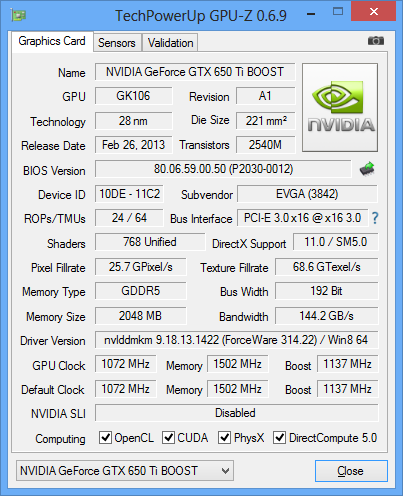Index
- EVGA GTX 650 Ti BOOST Superclocked reviewed
- Packaging
- A closer look at GTX 650 Ti Boost SC
- Testing methodology
- Nvidia Experience
- Crysis 3
- Crysis 2
- Far Cry 3
- Hitman Absolution
- Metro 2033
- Sleeping Dogs
- Dirt Showdown
- Aliens vs Predator
- 3DMark 11
- 3DMark
- Unigine Valley
- Unigine Heaven
- EVGA PrecisionX 4.0.0 & Overclocking
- Thermals, Noise and Consumption
- Conclusion
- All Pages


Review: Good performance at a tempting price
Nvidia apparently thought there is enough of a performance and price gap between the GTX 650 Ti and GTX 660, so it went ahead and developed the GTX 650 Ti Boost, which should plug the gap nicely. It is also worth noting that AMD introduced another mid-range card at about the same time, and that’s what it usually takes to get Nvidia’s tail wiggling.
As the name suggests, the GTX 650 Ti Boost features Nvidia’s GPU Boost technology, which was not employed on the plain GTX 650 Ti. GPU Boost allows the card to boost GPU clocks depending on load and temperature.
A simple clock boost with no additional changes would not have ensured the new Boost card a significant performance edge over the GTX 650 Ti. Luckily Nvidia had a few other tricks up its sleeve, so it widened the 128-bit memory bus to 192 bits, greatly improving bandwidth on the new card. In fact, thanks to the new bus and speedier memory chips, the new card has 66 percent more bandwidth compared to the plain GTX 650 Ti.
The basic design of Nvidia’s GTX 650 Ti, GTX 650 Ti Boost and GTX 660 revolves around GK106 silicon. The GTX 650 Ti, GTX 650 Ti Boost feature 768 CUDA processors, while the GTX 660 has 960. One SMX module on the GTX 650 Ti and GTX 650 Ti Boost is disabled, so they end up with fewer cores. The GTX 650 Ti Boost features 64 texture units, while the GTX 660 has 80. However, the Boost card shares some features with the GTX 660 as well, namely the 192-bit memory bus and 24 ROPs. Both cards ship with 2GB of GDDR5 memory.
We didn’t have a chance to try out a reference card, but we got something a bit better instead, EVGA’s GTX 650 Ti Boost Superclocked. The Superclocked card features base GPU clock at 1072MHz, while GPU Boost ups the clock to 1137MHz.
As you can see from the table below, the reference clocked GTX 650 Ti Boost is quite a bit slower than EVGA’s Superlocked card. EVGA did not overlock the memory though.
| GTX 650 Ti Boost | |
| Base Clock Speed | 980MHz |
| Typical Boost Clock | 1033MHz |
| OC Boost | 1100MHz+ |
| CUDA Cores | 768 |
| SMX Units | 4 |
| Memory speed | 6008MHz |
| Memory Subset | 192-bit |
| Memory Controller | 3x64-bit |
| Memory Capacity | 2048MB GDDR5 |
| Typical Draw (non-TDP Apps) | 115W |
| Typical Draw (non-TDP Apps) with slider at 110% | 127W |
| Power Connectors | 1x 6-pin PCIe |
| Length | 9.5” |
| Display outputs | 2x dual-link DVIs |
| HDMI | |
| DisplayPort |
The EVGA GTX 650 Ti Boost Superclocked is supposed to deliver high visual quality in games, with in-game detail settings cranked all the way up to High. We’ll see whether it lives up to this promise in our benchmarks. All we can say so far is that it is looking good, at least on paper and in GPUZ.

Following the introduction of the GTX 650 Ti Boost, Nvidia’s complete Geforce 6xx lineup consists of the following cards.
Geforce GTX TITAN (GK110)
Geforce GTX 690 (2xGK104)
Geforce GTX 680 (GK104)
Geforce GTX 670 (GK104)
Geforce GTX 660 Ti (GK104)
Geforce GTX 660 (GK106)
Geforce GTX 650 Ti BOOST (GK106)
Geforce GTX 650 Ti (GK106)
Geforce GTX 650 (GK107)
Geforce GT 640 (GK107)
Geforce GT 630 (re-branded Geforce GT 440)
Geforce GT 620
Geforce GT 610
The Geforce GTX 650 Ti Boost graphics card delivers the usual feature set, but there is some new stuff as well, namely GPU Boost, which is lacking from the plain GTX 650 Ti. For a limited time only, gamers who purchase select GeForce GTX 650 Ti Boost graphics cards will receive $75 in-game for Hawken, World of Tanks, and Planetside 2 ($25 for each game).
